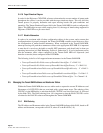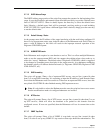
ADCP-75-192 • Issue 2 • June 2007
Page 32
© 2007, ADC Telecommunications, Inc.
3.4.16 Target Simulcast Degree
In order for the Digivance CXD/NXD software to determine the correct number of tenant paths
throughout the system, it can be provided with the target simulcast degree. This will allow the
Tenant process to properly determine and report missing boards and path conditions and
quantities. The Tenant Simulcast Degree field in the Tenant OAM MIB is used to configure this
object. This MIB object accepts values ranging from 1-8, the range of simulcasting supported in
Digivance CXD/NXD on a per sector basis.
3.4.17 Module Attenuators
In order to be consistent with all other configuration objects in the system, and to ensure that
configuration data is properly managed, the Tenant OAM MIB contains several objects to allow
the configuration of tenant module attenuators. When configured in the Tenant OAM MIB,
tenant processing will push these attenuators offsets to the appropriate HCP MIB. It is important
to note that it is not always desirable to modify HCP attenuators, and should only be done per
operating instructions (see Path Balancing, Section 4, Subsection 2). It is also important to note
that the attenuator offset values configured in the Tenant OAM MIB will supercede (and
therefore overwrite) those configured in the HCP MIBs.
The following is the list of all supported tenant attenuators in the Tenant OAM MIB:
• TransceptTenantGenTwoTable.transceptTenantRucYAttenOffset - Y = RAN 1-8.
• TransceptTenantGenTwoTable.transceptTenantRdcYAttenOffsetPrimary - Y = RAN 1-8.
• TransceptTenantMoreAttenTable.transceptTenantRdcYAttenOffsetDiversity - Y = RAN 1-
8.
• TransceptTenantMoreAttenTable.transceptTenantBimForwardAttenZOffset - Z = Path 1-2.
• TransceptTenantMoreAttenTable.transceptTenantHdcChXAttenOffset - X = Channel 1-8.
3.5 Managing the Tenant OAM Address and Hostname Tables
Within the Tenant OAM MIB, there are two tables used to capture the current IP Addresses and
Hostnames of all CPU/FICs that are associated with a given tenant sector. The ordering of the
CPU/FICs in the MIB tables is such that the RAN CPU/FICs are listed first from 1-8, followed
by the Hub CPUs. The RAN ordering from 1-8 is important so that the RAN CPU/FICs can be
correlated to the RAN ID values used throughout the Tenant OAM MIB.
3.5.1 RAN Ordering
The IP Address and Hostname tables in the Tenant OAM MIB indicate which RAN, based on IP
address and hostname, corresponds to RAN X, where X is the RAN ID (1-8).


















